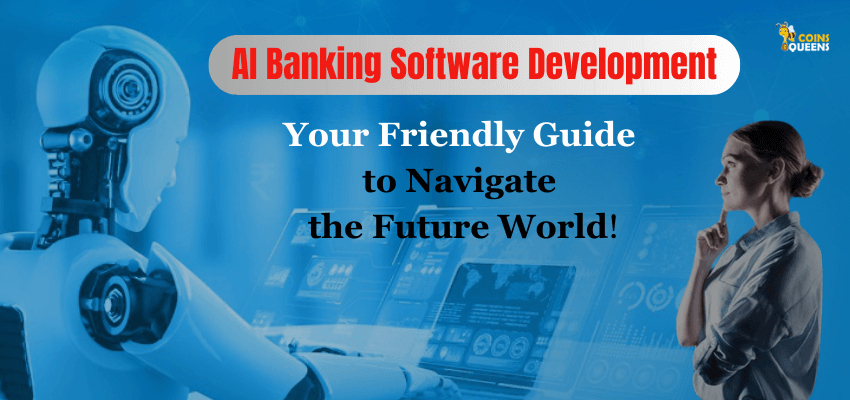Artificial Intelligence(AI) is quickly changing in several industries. Banking institutions must adopt these new technologies to stay competitive and relevant in the BFSI sector.
This is where AI technologies are essentially increasing.
Nowadays, AI Banking Software and Applications have fundamentally transformed how businesses can access and manage their accounts.
It looks interesting, right?
I am here to explain a detailed guide about AI Banking Software and How it can help you in your businesses.
So, Are you Ready to jump into the future world with advancements in AI?
Let’s get Started!
A Glimpse of AI Software in Banking:
AI banking software refers to a type of technology that uses computers to learn and think like humans. This helps banks and financial companies do their jobs better.
This technology can make tasks in banking easier by doing things like making decisions faster, making tasks automatic, and improving how customers feel about the bank.
Right now, many banks are using AI to make their work better. They use it to decide things, make their tasks smoother, make customers happier, and understand important information from data
Let’s explore how banks are using AI for their purposes.
Familiar Use Cases of AI in Banking:
In the banking sector, there are many opportunities for social contact. And this offers generative AI a huge opportunity to make significant changes.
Here, I share some essential use cases of AI Banking, Let’s dive!
Chatbots
The majority of banks now use chatbots to handle customer enquiries. Bankers can use extensive language models that can communicate like humans using AI.
Portfolio Management
Banks can use generative AI to take a more exact approach when suggesting customers on portfolio strategies. Large-scale economic data is used to train the deep learning model first.
Then, to create a suitable portfolio, bankers utilize the AI system to predict future trends based on a variety of changing financial variables, such as currency rates, inflation, and political dynamics.
It happens without forcing customers to publicly disclose their financial situations, which creates a more friendly and private banking environment.
Financial Analysis and Prediction
Like all other businesses, banks must plan to stay competitive in changing market conditions. They can perform simulations, forecast economic trends, and modify their positions as required.
For Example, banks can use AI to expect the rise over the next few years and alter interest rates accordingly.
Financial Advisor
Using AI, Banks can engage each customer equally and uniquely. Before recommending goods that can be of interest to the customer, the deep learning model estimate their past data, spending patterns, and risk tolerance. This raises sign-up rates and helps in keeping current clients.
AI-Based Fraud Detection
Banks are hassled by regulators to protect customers’ interests and stop fraud attempts because data violates are so common. Using massive amounts of financial transactions, generative AI may be trained to spot unusual patterns and issue fast alarms.
This enables banks to prevent questionable transactions and preserve client confidence.
Automation of Back-Office Processes
To work back-office operations like document scanning, employee identity verification, and securing networking infrastructure, banks make significant investments in their employees.
Generative AI integration eases some of the workload for the operational group. For example, they can scan, analyze, and categorize physical documents in safe cloud storage using NLP software.
Financial Report Generation
Machine learning models that can display organized data are the foundation of generative AI. This enables banking AI systems to instantly produce financial statements using automation.
For instance, Customers can ask for personalized cash flow or income reports, which the AI turns into files in seconds.
Exciting Benefits of Utilizing AI in Banking:
After integrating AI into their customer-facing and internal business operations, banks have experienced significant benefits.
Amongst them are listed below.
-
- Better decision-making
-
- Personalized Customer Experiences
-
- More Robust Security
-
- Enhanced Risk Management
-
- Improved Efficiency
-
- More Privacy
-
- AI-assisted regulatory compliances
Future of AI in the Banking Industry:
The advancement of artificial intelligence is pushing the financial sector towards a revolutionary change.
The banking sector has already seen a radical effect from AI, which has automated processes, improved client experiences, reduced risks, increased efficiency, and changed overall operations.
The potential of AI applications in banking is still new, and those opportunities will likely be much more lucrative. In the upcoming years, it is expected that better techniques for implementing AI will reshape banking processes.
Overall, it appears that AI in banking has a very encouraging future. Including AI in working operations will provide banks with a competitive edge and help them reach new heights.
They can make wiser choices, offer more individualized services, cut expenses, and boost production to greater degrees.
Therefore, to keep ahead of the turn in the constantly changing digital landscape, banks must analyze and test out AI technology.
Top 5 AI Banking Software
Arago
Arago, a leading provider of AI software, plans to assist organizations, particularly banks, in implementing automation in their IT processes.
UBS Group AG, a Swiss multinational company, offers clients in more than 50 countries financial services and consulting.
UBS has been utilizing Arago’s AI software since 2016, in particular, their HIRO platform for problem-solving AI.
Capable of handling business or IT activities automatically.
Ayasdi
Ayasdi creates machine learning-based AI applications that give users wise data.
Ayasdi’s software not only lets customers track events in real time but also controls risk and inefficiency.
Additionally, it helps users in avoiding dangers and developing robust systems that maximize the usage of company data.
This permits the minimization of false positives in fraud detection processes for users in the banking industry.
Additionally, it helps in stopping money cleaning.
One of the biggest banks in the world, HSBC, became involved in a global money-laundering scandal in 2017.
Since then, HSBC has been automating and enhancing compliance tests using AI software created by Ayasdi.
Additionally, the software helps in spotting irregular behavior.
CloudWalk
One of the top makers of facial recognition software is Cloudwalk which is a Chinese company.
According to estimates, Cloudwalk holds 30% of the facial recognition market in China.
The Bank of China, one of the biggest state-owned commercial banks in China, has been utilizing Cloudwalk’s AI software since 2015.
The bank first started using Cloudwalks’ infrared anti-theft technology.
This is capable of precisely recognizing people by scanning their faces.
CogniCor
The creators of the Conversational AI Platform, CogniCor, use AI tools to create digital assistants for the financial management industry.
The global provider of banking and financial services is OCBC Bank, headquartered in Singapore.
Emma, OCBC’s chatbot for home and loan remodelling services, is powered by artificial intelligence (AI) software created by CogniCor.
Following three months of training, Emma was sent into service.
She can answer any inquiries a client could have regarding mortgages or financing for home improvements.
High Radius
HighRadius, a provider of software as a service, uses autonomous systems with AI.
This gives its clients the option to automate and enhance the Treasury and Accounts Receivable processes.
Processes that “reduce cycle time in order-to-cash” are made possible by the organization’s Integrated Receivables platform.
To do this, artificial intelligence (AI) software is used to automate various payment procedures, including electronic billing, credit processing, cash application, deduction, and collection processes.
Actual World Example of AI in Banking:
As was said above, a few large banks have already started implementing artificial intelligence technologies to raise customer satisfaction, detect fraud and cybersecurity concerns, and improve service quality.
Some of them are mentioned here, Let’s get to see!
-
- JPMorgan Chase
-
- Capital One
-
- A European Bank
-
- Goldman Sachs
-
- Merrill Lynch
Step by Step Process to become an AI-first bank
Now that we’ve seen how AI is utilized in banking, in this section, we’ll examine the measures that banks can take to adopt AI broadly and modernize their operations while paying the necessary attention to the four essential components – people, governance, process, and technology.
-
- Develop an AI Strategy
-
- Plan a Use case-Driven Process
-
- Develop and Deploy
-
- Operate and Monitor
How CoinsQueens can help you with AI in Banking Drive?
Due to the numerous advantages of technology, AI and banking go hand in hand. According to a McKinsey analysis of a global AI survey, 60% of financial services organizations have at least one AI capability in place to speed up business operations.
This suggests that artificial intelligence in banking has a bright and exciting future. With the ability to improve client experience, minimize errors, and streamline procedures, AI is collected to transform the banking industry.
Thus, to provide customers with innovative experiences and top-notch services, all banking institutions must invest in AI technologies.
CoinsQueens works with banks and financial institutions to develop unique AI and ML-based models that help enhance income, reduce expenses, and manage risks in many departments.
CoinsQueens is a leading AI Banking Software Development Company that offers high-end FinTech App Development Services. To develop and implement a long-term AI in banking plan that meets your needs in the most tech-friendly way.
Get in touch with our experts right away.
We can also help to Create your Own Blockchain Network.











